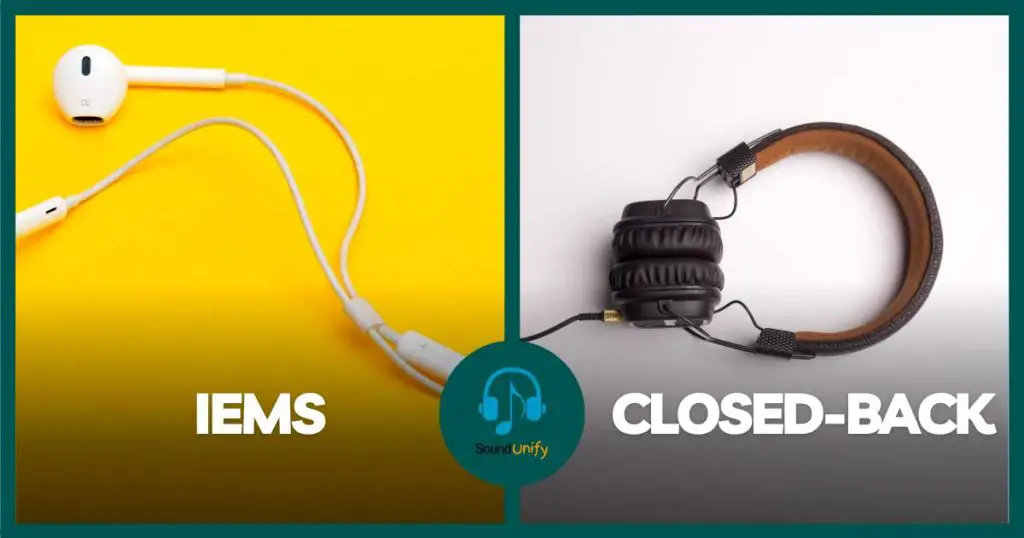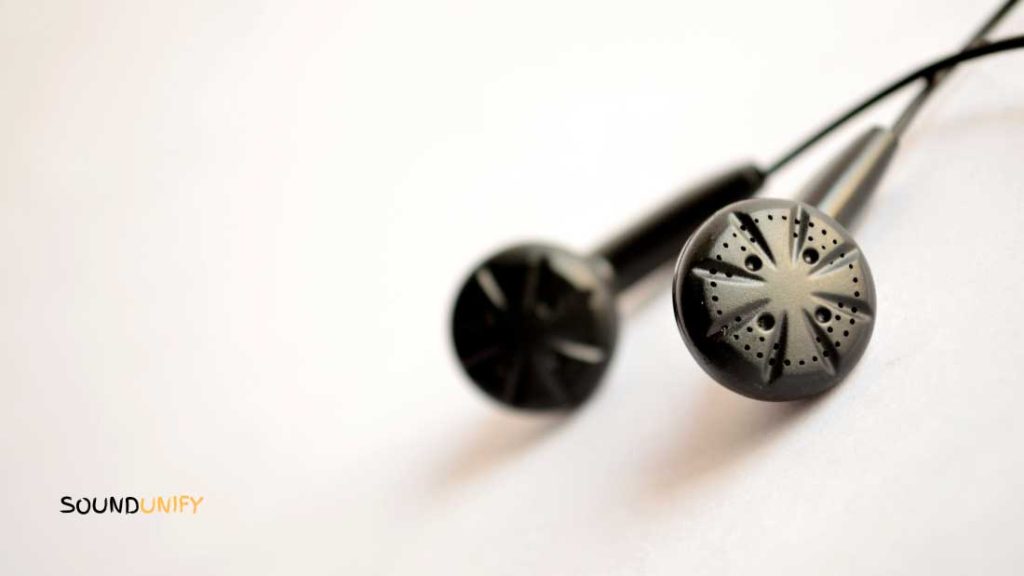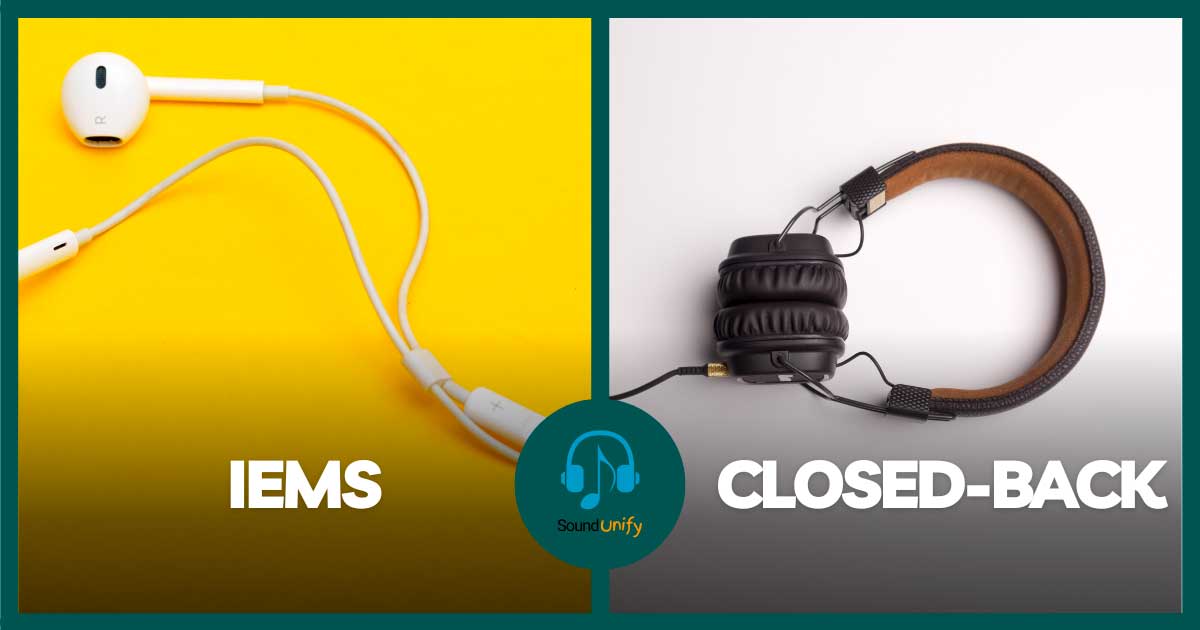Headphones are a piece of vital equipment for music lovers, audio engineers, and gamers. With so many types available on the market today, knowing which type is best for your specific needs can take time.
In-ear monitors (IEMs) and closed-back headphones are two popular types that offer different benefits, but which one is truly the superior choice?
To help you decide, let’s look at IEMs vs. closed-back headphones. We’ll compare their design, sound quality, comfort level, portability, noise cancellation features, usage scenarios, and durability and discuss their pros and cons so you can choose the right type of headphones for your needs.
Comparisons of IEMs vs. Closed-Back Headphones

When comparing IEMs to closed-back headphones, several factors must be considered. The design of IEMs vs. closed-back headphones can vary greatly.
For example, IEMs are typically smaller and more lightweight than their closed-back counterparts because they go directly into the ear canal. This makes them much more comfortable and portable than closed-back headphones, which require larger ear cups and headbands.
1. Design
The design of both IEMs and closed-back headphones dramatically impacts the overall user experience. IEMs are typically smaller and more lightweight than larger over-ear headphones, making them ideal for commuters and those who prefer a more discreet design.
On the other hand, closed-back headphones generally feature larger ear cups and a more robust headband to keep them securely in place, making them best suited for long listening sessions in the home or studio.
2. Sound quality
The sound quality between these two types of headphones also differs significantly. IEMs provide an incredibly accurate sound reproduction as they are designed to fit snugly inside your ear, blocking out outside noise and providing a punchy bass response.
On the other hand, closed-back headphones offer a more expansive soundstage but may only capture some details with their closed-back design.
3. Comfort
Comfort is another crucial factor when choosing between IEMs or closed-back headphones. Since IEMs go directly into your ears, they provide superior comfort compared to larger over-ear headphones, which can cause discomfort after extended use due to the pressure exerted on your ears by the headband and ear cups.
In addition, closed-back headphones may cause sweat build-up in warmer climates due to their lack of breathability compared to IEMs.
4. Noise cancellation
Noise cancellation is also necessary when comparing these two types of headphones as it determines how much external noise will be blocked out while using each type of headphone.
While both types offer some degree of noise cancellation through passive isolation, active noise cancellation is available exclusively on closed-back headphones, allowing for more controlled sound blocking without compromising audio quality.
5. Durability
In terms of durability, IEMs are typically less durable than closed-back headphones due to their small size and delicate components. They are also more susceptible to damage from sweat or moisture, making them a less ideal choice for active use or sports activities.
On the other hand, closed-back headphones tend to be more rugged and durable due to their larger form factor and thicker materials. They can also handle more abuse without suffering any significant damage.
6. Portability
Portability is also an essential factor to consider when choosing between IEMs and closed-back headphones. Since IEMs are smaller and typically feature interchangeable ear-tips for more comfortable listening, they are often the better choice for commuters and those on the move.
By contrast, closed-back headphones are larger, less discreet, and require cables, making them more suitable for stationary listening.
7. Usage
The usage scenarios between IEMs and closed-back headphones vary significantly. IEMs are ideal for musicians, sound engineers, and anyone who needs a real and isolated listening experience.
On the other hand, closed-back headphones are fabulous for home listening, casual gaming, and even studio use, thanks to their superior soundstage and robust build quality.
8. Price Range
Regarding price and durability, there are some notable differences between in-ear monitors (IEMs) and closed-back headphones. In general, IEMs tend to be more expensive than closed-back headphones. This is because they are typically made with higher-quality materials and components.
Additionally, IEMs tend to have a smaller form factor, making them more challenging to manufacture. As a result of their higher production costs, IEMs usually cost more than closed-back headphones.
Are In-Ear Monitors Worth the Money?

The answer to this question largely depends on the individual’s particular needs and preferences.
If you’re looking to upgrade your listening experience while performing on stage, investing in a pair of IEMs can make a massive difference in sound quality and clarity.
IEMs provide excellent isolation from onstage noise as they provide a direct path to your inner ear. This also allows you to tailor your sound more accurately to your needs.
Additionally, IEMs are beneficial in other ways. Many come with different filter and equalization settings, allowing you to customize the sound to your tastes. This feature is essential for musicians and audio engineers who want the perfect sound for live performances.
On top of the sound quality benefits, IEMs also cut down on bulky monitor speakers and monitor wedges. That can take up a lot of space in a small venue.
So, while there may be more affordable options, IEMs offer unique features and benefits that make them worthwhile if you want to upgrade your listening experience when performing on stage.
Their portability, sound quality, and customization make IEMs invaluable to any musician or audio engineer’s toolkit.
Are Closed-Back Worth the Money?

Closed-back headphones are worth the money for people who care about sound quality or need accurate sound reproduction. The primary benefit of closed-back headphones is the isolation they offer.
Because they’re designed to block out external sounds, they keep you focused on the sounds from the headphones without outside noise interfering. This makes them ideal for recording studios and other professional audio environments.
Additionally, closed-back headphones produce more accurate bass frequencies because they prevent sound waves from leaking out the back of the ear cup.
Overall, the tight seal of closed-back headphones means they can provide superior sound quality compared to their open-back counterparts.
Factors to Consider When Choosing Between Iems and Closed-Back Headphones
When selecting between IEMs (in-ear monitors) and closed-back headphones, there are several key points to consider.
- Purpose: Are you using headphones for music production, at-home listening, or on-the-go use? IEMs are ideal for music production and recording due to their sound isolation capabilities, while closed-back headphones provide a better sound stage and punchier bass for at-home listening.
- Comfort & portability: In-ear monitors are usually much smaller and more lightweight than closed-back headphones, making them significantly more portable and comfortable for on-the-go use.
- Durability: Closed-back headphones are more rugged and durable, whereas IEMs are more susceptible to damage due to their small size and delicate components.
- Sound quality: Both types offer their advantages in terms of sound quality. IEMs have more powerful bass, while closed-back headphones provide a wider soundstage.
- Noise cancellation: Closed-back headphones offer better noise cancellation thanks to their active noise cancellation technology.
- Higher-end models may provide better audio experiences: IEMs and closed-back headphones come in various price points. Higher-end models often come with better audio capabilities and features.
Overall, both types have pros and cons, and you should carefully consider which type best meets your needs. Whether you’re looking for a better listening experience for music production or more casual listening, the correct type of headphones will make all the difference in your overall experience.
FAQ
Are IEMs suitable for long listening sessions?
Yes, in-ear monitors (IEMs) are designed to stay comfortable in your ears even during longer listening sessions. Because they are inserted directly into the ear canal, they create a seal that helps block out external noise.
This also prevents sound leakage, which enables you to enjoy high-quality music without disturbing others. However, some users may be uncomfortable after extended use or if worn incorrectly.
Can IEMs be used to make phone calls?
Yes, many IEMs come with built-in microphones and can be used for making and receiving phone calls. Generally speaking, the sound quality of these devices is excellent when talking on the phone as the microphone can capture sound from inside the ear canal more accurately than a regular headset microphone.
How does noise cancellation work on closed-back headphones?
Closed-back headphones provide a good level of noise cancellation by blocking out external sounds with their sealed design.
The headphones cups form an airtight barrier around your ears, which reduces ambient noise from entering your ears and ensures that you’re only hearing what’s coming through the headphones.
Additionally, some closed-back headphones come with active noise cancellation technology that uses built-in microphones and processors to detect and reduce background noise levels even further.
Do IEMs have good bass?
Yes, IEMs can provide punchy and powerful bass. This is due to their snug-fitting design, which blocks out external sounds and creates an airtight seal inside the ear canal. This tight seal helps to produce precise, accurate bass tones and can provide a more impactful listening experience.
Why are in-ear monitors better than closed-back headphones?
Compared to closed-back headphones, IEMs offer greater comfort, portability, and sound isolation due to their smaller form factor.
Additionally, IEMs are designed to fit snugly in the ear canal and provide superior sound accuracy, making them an excellent choice for sound engineers and performers.
Finally, because they don’t require headbands, IEMs are much less bulky and easily stored in a pocket or purse.
Why do audiophiles like IEMs?
Audiophiles tend to prefer IEMs because of their superior sound quality and accuracy. The snug fit of IEMs inside the ear canal helps create a seal and block out external noise more effectively than open-back headphones, resulting in a more detailed sound.
Additionally, IEMs are typically thinner and less bulky than over-ear headphones, so they can provide a more discerning listening experience that appeals to audiophiles.
Conclusion
You must consider your personal needs when choosing between IEMs and closed-back headphones. Both headphones have advantages and disadvantages, from design and comfort to sound quality and noise cancellation.
With IEMs, you get a more authentic listening experience with the ability to customize the fit for maximum comfort.
Still, they may not be suitable for loud environments or long listening sessions due to their lower sound isolation. On the other hand, closed-back headphones offer superior sound isolation and are more durable than IEMs.
They may be less comfortable depending on how tightly they fit around your ears.
Ultimately, no matter which type of headphone you choose, ensure that it meets your needs in terms of comfort and sound quality while also fitting within your budget.
James Dimento is a Chief-in-Editor of SoundUnify. He is a headphone enthusiast and creative writer passionate about audio technology. He has three years of experience writing about headphones and sound quality and is responsible for creating reviews and taking care of all administration.
